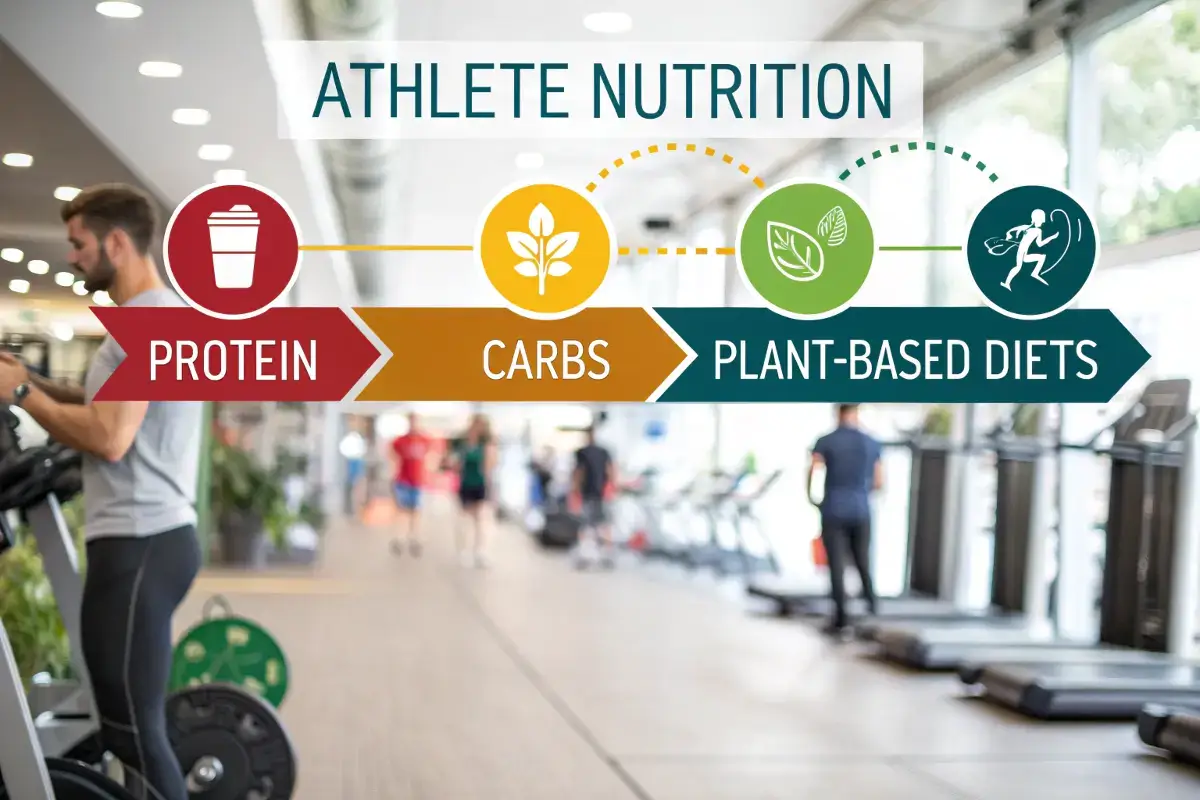Athletes understand that performance is not just about training hard—it’s about eating right too. Over the years, special diets tailored to athletic needs have evolved dramatically, driven by advancements in sports science and changing trends in nutrition. From the protein-heavy regimens of the past to the rise of plant-based diets and personalized nutrition plans, the landscape has continuously shifted.
This article takes you on a comprehensive timeline of special diets for athletes, exploring their historical roots, scientific principles, and practical applications for modern-day performance optimization. Whether you’re an endurance runner, a strength-focused lifter, or a recreational athlete, understanding the evolution of these dietary practices can empower you to fine-tune your nutrition for peak results.
Introduction to Special Diets for Athletes
The Importance of Nutrition in Sports
Nutrition isn’t just fuel for athletes—it’s a game-changer. The food an athlete eats can influence energy levels, recovery time, and even mental focus. For decades, researchers have studied the link between nutrition and athletic performance, uncovering how macronutrients, hydration, and timing affect success on the field, track, or court.
Athletes require precise dietary strategies because their physical demands are so intense. A soccer player needs energy-dense carbs, while a powerlifter prioritizes protein for muscle repair. Without proper nutrition, even the most talented athletes risk underperforming or facing fatigue.
Understanding the Evolution of Diets in Athletics
Believe it or not, early athletes didn’t always prioritize nutrition. Ancient Olympians consumed simple grains, figs, and honey, unaware of modern concepts like protein synthesis or glycogen storage. By the 20th century, science started shaping sports nutrition, introducing high-protein meals, energy bars, and advanced supplements.
Today, athletes are spoiled with options—everything from ketogenic diets to personalized meal plans guided by data from wearables and blood tests. This evolution reflects growing awareness of how diet directly impacts physical and mental performance.
Key Factors Shaping Dietary Trends Over Time
Several factors have shaped the timeline of special diets for athletes:
- Scientific Advances: Research into energy systems, muscle recovery, and hydration science has transformed dietary recommendations.
- Cultural Influences: Trends like veganism or low-carb eating have made their mark on the sports world.
- Technological Innovations: From protein powders to glucose-monitoring tech, new tools have enabled more precise nutritional strategies.
These factors have guided the development of specialized diets, making nutrition as much a part of an athlete’s toolkit as their equipment.
Historical Timeline of Special Diets in Sports Nutrition
Early Dietary Practices in Sports (Pre-20th Century)
The connection between nutrition and athletic performance is not new. Ancient Greek Olympians relied on simple, carb-heavy foods like barley bread, figs, and honey for energy. Protein-rich diets were largely absent in these early days. Surprisingly, athletes believed certain foods, such as goat meat, could boost stamina and strength. These practices laid the groundwork for today’s focus on sports-specific nutrition.
The Rise of High-Protein Diets in the 1960s and 1970s
In the mid-20th century, protein became the star of athletes’ diets. Bodybuilders like Arnold Schwarzenegger popularized high-protein meals, emphasizing meat, eggs, and dairy for muscle growth. Nutrition science of this era began to underline the role of amino acids in muscle repair, ushering in the protein-focused diets still celebrated today.
Introduction of Energy Bars and Supplements in the 1980s
The 1980s marked a pivotal moment for convenience-based nutrition. Products like PowerBar and Gatorade became staples for athletes looking for quick energy and electrolyte replenishment. This era also introduced creatine and protein powders, transforming how athletes approached pre- and post-workout meals.
Low-Carb and Ketogenic Diets in the 2000s
With growing interest in fat metabolism, low-carb and ketogenic diets gained traction in the early 2000s. Many endurance athletes experimented with reducing carbs and increasing healthy fats to enhance performance. While controversial, the trend showcased a shift toward personalized and experimental nutrition strategies.
Current Trends: Plant-Based Diets and Personalized Nutrition
Today’s sports nutrition reflects both ethical and technological advancements. Plant-based diets have gained popularity among athletes, fueled by documentaries like The Game Changers. Simultaneously, personalized meal plans using blood tests and DNA analysis have taken sports nutrition to a new level, making diets more tailored than ever before.
For high-protein recipes that complement modern sports nutrition, check out this guide to meal prep recipes for muscle building.
Nutritional Needs for Different Types of Athletes

Endurance Athletes and Carbohydrate-Rich Diets
Endurance athletes like marathon runners or cyclists rely on carbs as their primary energy source. Carbohydrate-loading before long events ensures glycogen stores are fully stocked. Foods like pasta, rice, and whole grains provide the slow-release energy needed for sustained performance.
Strength Athletes and Protein Intake
For strength athletes, muscle repair and growth take center stage. High-protein diets filled with chicken, fish, eggs, and legumes are essential for repairing damaged muscle fibers after intense workouts. Protein shakes are also a convenient option to hit daily intake goals quickly.
For protein-packed breakfasts ideal for strength-focused athletes, check out high-protein breakfast ideas.
Dietary Adjustments for Mixed-Sport Athletes
Athletes in sports that combine endurance and strength, like soccer or basketball, face unique challenges. These athletes need balanced diets that include adequate carbs, proteins, and fats to support diverse energy demands. Hydration is also critical during these high-intensity sports.
Hydration and Micronutrient Requirements
Proper hydration is often underestimated in sports nutrition. Electrolyte-rich beverages help athletes replenish sodium, potassium, and magnesium lost through sweat. Micronutrients like calcium, iron, and vitamin D also play a vital role in bone health and oxygen transport, essential for athletes at any level.
By understanding the special diets for athletes timeline, you can adopt a diet that aligns with your fitness goals and sport-specific needs.
Science Behind Special Diets for Athletes
How Macronutrients Influence Performance
Macronutrients—carbohydrates, proteins, and fats—are the backbone of any athlete’s diet. Carbohydrates act as the body’s primary fuel source, particularly during high-intensity activities like sprinting or weightlifting. Protein, on the other hand, is essential for muscle repair and growth, making it critical for recovery after workouts. Lastly, healthy fats help sustain energy during long-duration, lower-intensity efforts, such as endurance races.
For athletes, balancing these macronutrients depends on the type of sport and intensity level. For example, a marathon runner might need more carbs than a bodybuilder, who prioritizes protein. This balance ensures the athlete can maximize performance while speeding up recovery times.
Role of Micronutrients and Recovery
While macronutrients steal the spotlight, micronutrients are equally vital for peak performance. Calcium strengthens bones, reducing the risk of fractures, while iron helps transport oxygen to muscles, improving endurance. Vitamins C and E combat oxidative stress caused by intense physical activity, aiding in recovery.
Electrolytes like sodium and potassium play a major role in hydration, especially for athletes who lose these minerals through sweat. Failing to replace them can lead to muscle cramps and fatigue.
The Science of Periodized Nutrition
Periodized nutrition is a strategy that aligns dietary intake with training cycles. Athletes vary their macronutrient ratios depending on the phase of their training—focusing on carbs during heavy training weeks and protein during recovery periods. This tailored approach ensures the body gets what it needs when it needs it, enhancing both performance and recovery.
Emerging Research: The Gut Microbiome and Athletic Performance
Recent studies suggest the gut microbiome—home to trillions of bacteria—may play a role in athletic performance. A healthy gut aids digestion and nutrient absorption, while an imbalance can lead to inflammation and slower recovery. Probiotic-rich foods like yogurt and fermented vegetables can support gut health, a growing focus in modern sports nutrition.
For more ideas on incorporating nutrient-dense recipes into your diet, explore healthy meal recipes for athletes.
Practical Tips for Implementing a Special Diet
How to Assess Your Nutritional Needs
Understanding your nutritional needs is the first step in adopting a special diet. Start by identifying your athletic goals—whether it’s building muscle, improving endurance, or simply maintaining overall fitness. Consult a sports dietitian who can create a personalized plan based on your body type, sport, and training schedule.
Tools for Tracking and Monitoring Dietary Intake
Tracking your food intake can help ensure you’re meeting your nutritional goals. Apps like MyFitnessPal or Cronometer let you log meals and analyze macronutrient breakdowns. For a more advanced approach, wearable devices can monitor calories burned and hydration levels during workouts, helping you adjust your diet accordingly.
Working with Nutritionists and Sports Dietitians
While online tools are helpful, nothing beats personalized advice from a professional. A sports dietitian can tailor a diet to your training schedule, ensuring you consume the right nutrients at the right times. They can also recommend specific supplements or foods to address deficiencies or improve recovery times.
For more delicious, nutrient-packed meal ideas, check out healthy breakfast recipes for athletes.
FAQs and Common Concerns
What Are the Best Diets for Athletes with Specific Allergies?
Navigating allergies while maintaining an effective diet can be tricky for athletes. For those with gluten intolerance, options like quinoa, rice, and potatoes provide excellent carbohydrate sources. Dairy-free athletes can turn to plant-based milk, almond yogurt, and vegan protein powders for nutritional balance.
It’s essential to work closely with a dietitian to ensure nutrient deficiencies don’t occur. Adjusting your diet while staying true to your training demands ensures that allergies don’t compromise performance.
How Do Special Diets Impact Recovery After Injury?
Injuries are inevitable for athletes, but recovery can be optimized through diet. High-protein foods promote muscle repair, while foods rich in omega-3 fatty acids, like salmon and walnuts, reduce inflammation. Incorporating collagen or gelatin can help heal connective tissues.
Injured athletes also benefit from vitamin C-rich foods, such as oranges and bell peppers, to support tissue repair. Ensuring a balanced diet during recovery aligns with the lessons learned from the special diets for athletes timeline by speeding up healing.
Can Athletes Safely Follow Vegan or Plant-Based Diets?
Yes! Many athletes thrive on plant-based diets, as long as they plan carefully. Protein needs can be met with beans, lentils, tofu, and seitan. B12 and iron supplementation may be necessary, so consulting with a dietitian is highly recommended.
Conclusion: Shaping the Future of Special Diets in Sports
Trends to Watch in Sports Nutrition
The world of sports nutrition is constantly evolving. As seen in the special diets for athletes timeline, trends like plant-based eating, personalized nutrition plans, and gut microbiome research are shaping how athletes fuel their bodies. Future innovations may include AI-driven meal plans or more advanced supplements designed to enhance performance without side effects.
Athletes are also prioritizing sustainability, seeking diets that not only fuel their performance but are eco-friendly. Plant-forward approaches and regenerative farming products are gaining traction in this space.
Final Tips for Athletes Adopting a Special Diet
Implementing a special diet starts with understanding your body’s needs and finding foods that align with your goals. Focus on balance—no single macronutrient or food group should be ignored. Don’t shy away from seeking professional guidance, as sports dietitians can offer tailored advice for your specific sport and training intensity.
Ultimately, an effective diet is one you can sustain. By looking at how nutritional practices have evolved through the special diets for athletes timeline, you can confidently shape your eating habits to achieve optimal results.
Technology’s Role in Shaping Special Diets for Athletes

Wearable Devices and Nutrition Tracking
Modern athletes have access to advanced technology that tracks everything from calorie burn to nutrient deficiencies. Devices like fitness trackers and smartwatches can monitor hydration levels, sleep patterns, and energy expenditure in real time. These tools allow athletes to adjust their diets more precisely, ensuring their meals align with their training intensity.
For example, marathon runners can use this data to optimize carb-loading before a race, while strength athletes can track protein consumption during muscle-building phases. Such technology demonstrates how the special diets for athletes timeline has evolved with innovation.
AI-Driven Meal Plans and Personalized Nutrition
Artificial intelligence has taken personalization in sports nutrition to new heights. Apps and programs powered by AI can create meal plans tailored to an athlete’s specific needs, considering factors like age, gender, activity level, and even genetic data.
These systems can analyze biometric information to recommend nutrient-dense meals that enhance performance and recovery. Athletes no longer have to rely solely on trial and error; instead, they can trust technology to provide science-backed advice. As AI continues to advance, it’s likely we’ll see even more precise dietary recommendations that adapt to changing conditions in real time.
For more ideas on quick, nutritious meals, explore this guide to easy healthy dinners.
The Environmental Impact of Special Diets for Athletes
Sustainable Food Choices in Sports Nutrition
As awareness of environmental issues grows, athletes are increasingly turning to sustainable diets. Plant-based eating, for example, has become a popular choice due to its lower carbon footprint compared to meat-heavy diets. Athletes following the special diets for athletes timeline now seek foods that are both performance-enhancing and eco-friendly.
Sustainable choices include local, seasonal produce and responsibly sourced proteins like fish or poultry. These options not only support the planet but also provide the nutrients needed for peak performance.
Balancing Performance with Sustainability
While sustainable eating is a priority, athletes often worry that eco-friendly choices might compromise their performance. Fortunately, this isn’t the case. Foods like lentils, beans, nuts, and seeds offer plant-based protein, while quinoa and sweet potatoes provide the complex carbs necessary for endurance events.
By combining sustainable practices with strategic meal planning, athletes can fuel their performance while reducing their environmental impact. This balance reflects a shift in priorities, where nutrition is no longer just about individual success but also global well-being.
For eco-conscious recipes that fit your training goals, check out healthy plant-based ideas.

